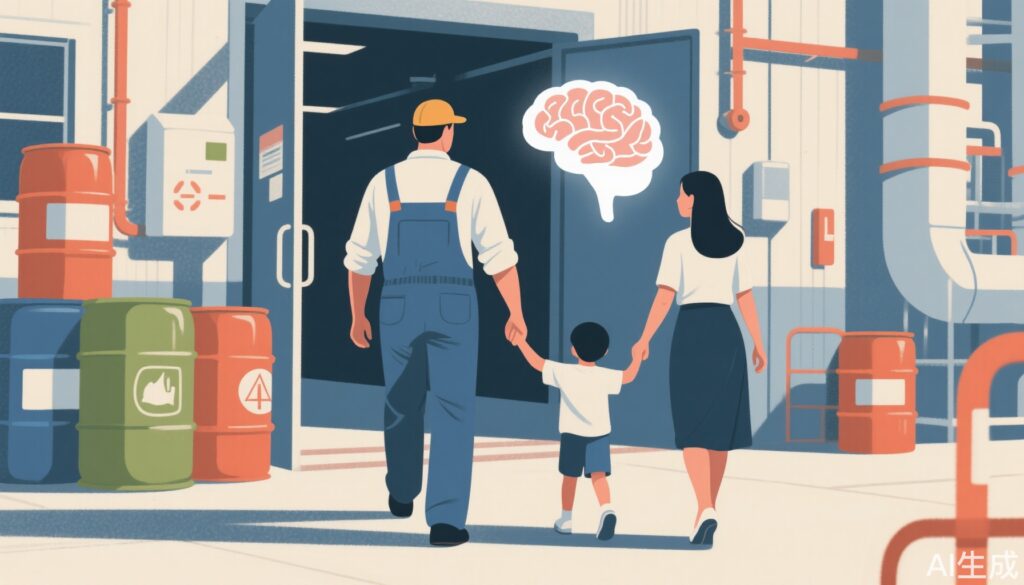Autism spectrum disorder (ASD) is a neurodevelopmental condition characterized by challenges with social communication and interaction, restricted or repetitive patterns of behavior, and variable abilities in cognition and daily living. A recent study published in the International Journal of Hygiene and Environmental Health examined whether parental workplace exposure to specific chemicals around the time of pregnancy is associated with autism severity and related functional outcomes among children already diagnosed with ASD.
This study analyzed data from the UC Davis CHARGE cohort and focused on more than 500 families with a child diagnosed with autism. Industrial hygienists reviewed parents’ job histories from three months before pregnancy through birth and estimated exposure to 16 classes of chemicals, including plastics and polymers (e.g., polyethylene, polypropylene, polyvinyl chloride), ethylene oxide, phenols, disinfectants, solvents, and other agents. Children’s autism severity was measured using the Autism Diagnostic Observation Schedule, 2nd edition (ADOS-2) Calibrated Severity Score (a widely used clinical measure), and assessments included cognition, adaptive (daily living) skills, and behavior.
Main findings
– Parental exposures to plastics and polymers were linked with poorer cognitive performance and reduced adaptive skills in children with ASD, and with more behavioral problems such as hyperactivity and social withdrawal.
– Paternal exposure to plastics and polymers showed particularly strong associations with lower scores in fine motor, visual reception, receptive language, and expressive language.
– Exposure to ethylene oxide (a sterilizing agent) was associated with higher ADOS-2 severity scores and weaker daily living skills.
– Phenol exposures were associated with increased autism severity and behaviors such as hyperactivity and repetitive movements or vocalizations.
What the results mean
These associations suggest that parental occupational exposures during sensitive windows around conception and prenatal development may be related not only to the chance of being diagnosed with autism (as previous studies have examined) but also to the severity and day-to-day functioning of autistic children. The results are associative — they do not prove that exposures caused the outcomes — but they point toward potential biological pathways and public health implications.
Possible mechanisms (brief)
– Many chemicals implicated (for example, some plastic-related compounds and sterilizing agents) can interfere with hormonal signaling, epigenetic regulation, or cellular development during fetal brain formation.
– Paternal exposures could affect sperm quality or epigenetic marks transmitted at conception, while maternal exposures may directly influence the intrauterine environment.
Limitations to consider
– Exposure estimation was based on job histories and expert judgment rather than individual exposure measurements (biomonitoring), which can misclassify true exposure levels.
– The sample size, although substantial, might be too small to detect associations for less common exposures or to fully separate effects among many correlated agents.
– Confounding factors (for example, socioeconomic status, co-exposures, lifestyle, and genetic susceptibilities) can influence results despite statistical adjustments.
Practical implications and recommendations
– Occupational safety matters for reproductive health as well as for the worker. Employers and occupational health programs should prioritize reducing worker exposure to known hazardous agents, particularly for people who are pregnant or planning pregnancy.
– Workers planning conception should discuss workplace risks with occupational health professionals, who can review job tasks, substitute safer materials, improve ventilation, provide personal protective equipment (PPE), and consider temporary reassignments when appropriate.
– Healthcare providers caring for prospective parents can include occupational exposure screening as part of preconception and prenatal counseling.
Research and policy needs
– More prospective studies with direct exposure measurements (air monitoring, biomonitoring) and larger sample sizes are needed to replicate and refine these findings.
– Studies should include fathers systematically, because this study highlighted several associations linked to paternal exposure.
– Mechanistic research (animal and human molecular studies) can help identify how particular agents impact neurodevelopment and which exposure windows are most critical.
Caution for readers
This study adds meaningful evidence linking parental workplace exposures with variations in autism severity and function, but it does not demonstrate causation. Families should not assume a specific parental job caused their child’s condition. Instead, the study emphasizes the importance of occupational safety and further research to protect future generations.
Journal reference
McCanlies, E. C., et al. (2025). The effects of parental occupational exposures on autism spectrum disorder severity and skills in cognitive and adaptive domains in children with autism spectrum disorder. International Journal of Hygiene and Environmental Health. doi.org/10.1016/j.ijheh.2025.114613 IF: 4.4 Q1


